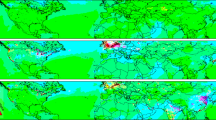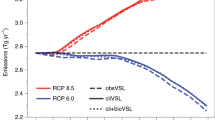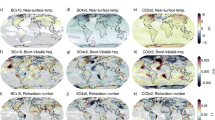Abstract
Ozone is an air pollutant that can cause severe respiratory health effects. Photochemical ozone production near the Earth’s surface is considered a summertime, urban phenomenon1,2,3, where hourly average ozone concentrations can exceed 150 p.p.b., compared with background values of about 50 p.p.b., and wintertime ozone concentrations in the US are usually in the range of 35–50 p.p.b. (refs 1, 2, 3). Here we report rapid, diurnal photochemical production of ozone during air temperatures as low as −17 ∘C, in the rural Upper Green River Basin, Wyoming, in the vicinity of the Jonah–Pinedale Anticline natural gas field. We find that hourly average ozone concentrations rise from 10–30 p.p.b. at night to more than 140 p.p.b. shortly after solar noon, under the influence of a stagnant, high-pressure system that promotes cold temperatures, low wind speeds and limited cloudiness. Under these conditions, an intense, shallow temperature inversion develops in the lowest 100 m of the atmosphere, which traps high concentrations of ozone precursors at night. During daytime, photolytic ozone production then leads to the observed high concentrations. We suggest that similar ozone production during wintertime is probably occurring around the world under comparable industrial and meteorological conditions.
This is a preview of subscription content, access via your institution
Access options
Subscribe to this journal
Receive 12 print issues and online access
$259.00 per year
only $21.58 per issue
Buy this article
- Purchase on Springer Link
- Instant access to full article PDF
Prices may be subject to local taxes which are calculated during checkout


Similar content being viewed by others
References
Logan, J. A. Ozone in rural areas of the United States. J. Geophys. Res. 94, 8511–8532 (1989).
Pinto, J. P., Rizzo, M., McCluney, L. & Fitz-Simons, T. Extended Abstracts, Ninth Conf. on Atmospheric Chemistry 1–7 (American Meteor. Soc., 2007).
Trainer, M. et al. Models and observations of the impact of natural hydrocarbons on rural ozone. Nature 329, 705–707 (1987).
US EPA; <http://www.epa.gov/air/ozonepollution/standards.html>.
<http://deq.state.wy.us/out/downloads/ozonealert2.26.08.doc>.
UGWOS 2008 Database 8/04/2008 available at <http://deq.state.wy.us/aqd/Monitoring%20Data.asp>.
Wyoming Oil and Gas Conservation Commission Online Database: <http://wogcc.state.wy.us/>.
<http://www.eia.doe.gov/emeu/recs/recs2005/hc2005_tables/c&e/excel/ tableus3.xls>.
Jonah Infill Final EIS and Record of Decision and Pinedale Supplemental Final EIS and Record of Decision: <http://www.blm.gov/wy/st/en/info/NEPA/pfodocs/jonah.html>.
Whiteman, C. D. Breakup of temperature inversions in deep mountain valleys: Part I. Observations. J. Appl. Meteorol. 21, 270–289 (1982).
Whiteman, C. D. & McKee, T. B. Breakup of temperature inversions in deep mountain valleys: Part II. Thermodynamic model. J. Appl. Meteorol. 21, 290–302 (1982).
Crutzen, P. J. in Composition, Chemistry, and Climate of the Atmosphere (ed. Sing, H. B.) 349–393 (Van Nostrand Reinhold Publ., 1995).
Tropospheric Ultraviolet and Visible radiation (TUV) model, National Center for Atmospheric Research; <http://cprm.acd.ucar.edu/Models/TUV/>.
Total ozone data: <http://jwocky.gsfc.nasa.gov/teacher/ozone_overhead_v8.html>.
Danielsen, E. F. Stratospheric–tropospheric exchange based on radioactivity, ozone and potential vorticity. J. Atmos. Sci. 25, 502–518 (1968).
Acknowledgements
This research was supported by the NOAA, Earth System Research Laboratory, Boulder, Colorado. Data were provided by the Wyoming Department of Environmental Quality, Cheyenne, Wyoming. P. J. Crutzen, Max-Planck Institute, Mainz, Germany, and D. D. Parrish and J. A. deGouw, NOAA Earth System Research Laboratory, Boulder, Colorado, provided helpful suggestions on ozone formation chemistry.
Author information
Authors and Affiliations
Contributions
R.C.S., S.J.O., R.R.N., J.V.M. and A.B.W. conducted the data analysis; J.V.M. assisted in field data collection and ran the TUV model; M.S.E. brought the ozone-production phenomenon to our attention and facilitated access to the data. Conclusions expressed should be considered those of the NOAA authors.
Corresponding author
Rights and permissions
About this article
Cite this article
Schnell, R., Oltmans, S., Neely, R. et al. Rapid photochemical production of ozone at high concentrations in a rural site during winter. Nature Geosci 2, 120–122 (2009). https://doi.org/10.1038/ngeo415
Received:
Accepted:
Published:
Issue Date:
DOI: https://doi.org/10.1038/ngeo415
This article is cited by
-
Unraveling Street-Level Air Pollution upon a Pivotal City of Yangtze River Delta, China
Aerosol Science and Engineering (2021)
-
Exploring the endocrine activity of air pollutants associated with unconventional oil and gas extraction
Environmental Health (2018)
-
Reversal of global atmospheric ethane and propane trends largely due to US oil and natural gas production
Nature Geoscience (2016)
-
Observations of high level of ozone at Qinghai Lake basin in the northeastern Qinghai-Tibetan Plateau, western China
Journal of Atmospheric Chemistry (2015)
-
Air concentrations of volatile compounds near oil and gas production: a community-based exploratory study
Environmental Health (2014)



